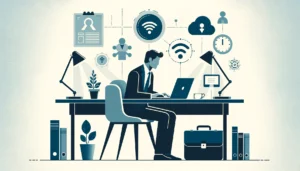The blurring line between life and work
- 4 Min Read
The disruptions that technology has had on the work landscape have blurred the line of life and work. HRD Connect explores the possibilities of maintaining a healthy balance.
- Author: Louron Pratt
- Date published: Sep 6, 2019
- Categories

From work-based instant messaging tools to automated chatbots, digital developments in the working world are taking their toll. These state-of-the-art inventions are making things more difficult to switch off after leaving work. Today, many employees have their work emails or messaging tools on their smartphones, which makes it troublesome to strike a balance between life and work. How can employers help their employees find a balance?
The digital workplace gives employees the tools they need to improve their communication, collaboration and connections with each other. Although there are many benefits for companies that choose to implement these digital advances into their workforce, the increasing accessibility of these tools, mean that many employees struggle to stay off of these apps outside of working hours.
According to research by the CIPD/Halogen Employee Outlook report, 32% of workers feel that having remote access to the workplace through digital software, means they can’t switch off in their personal time.
“The agility and the flexibility of these tools suggests that we can connect anywhere. The balance between personal and professional time tends to blur. Workplace digital tools are used to easily connect people all the time, everywhere they go,” said Abe Smith, Head of International, Zoom.
“The cautionary element is having to manually turn your alerts off. Choices like that are important because you must have that time when you’re not distracted.”
“The key is knowing when not to be available, and when to turn it off. If this is done right, you have time for yourself, your family, and your friends, which is extremely important for human psychology.”
Research carried out by Regus found that over 50% of workers work outside their main office for 2.5 days a week or more. This could create a spark in employees struggling to have a clear balance between life and work.
A study by Bently University showed that millennials prefer more freedom of location, and 77% report that flexible work would make them more productive. As Millennials will compose 50% of the workforce by 2020 it’s key for businesses to see to their expectations.
“Organisations hold a unique position to promote higher activity levels because they have credibility and massive reach among employees. It´s time they make the most of this,” said Abe.
While some responsibility lies with employees who must develop the ability to strike a work-life balance, there are many things business leaders can do to encourage their workforce to find this equilibrium.
“In today’s business environment, many candidates having the ability to work flexibly is a high priority. It’s equally important for them to be able to switch off outside of working hours. Therefore, the companies that allow remote work and flexible schedules, and have the technology in place that supports these options, will be more appealing to potential talent.” said Megan Barbier, VP of Human Resources at Wrike
“Businesses need to make sure that their technology is empowering their workforce – rather than being another distraction or burden, causing increased stress levels or even burnout. Technology should encourage flexibility and allow employees to disconnect – not promote a 24/7 workday.”
Additionally, many tools can help employees find a balance. Studies commenced by Wrike found that 91% of UK respondents said these tools could potentially help them to switch off and create a better work-life balance.
“Our lives have been utterly transformed by the magic of technology in the past 10 years.”
“Our machines give us the power to go faster than ever – to infinity and beyond. For the hyperconnected, there is no quiet moment – email inboxes are bottomless, the news is always breaking somewhere in the world and social media streams flow relentlessly.” says April Doty, Community Manager, Mindsatwork.
In this hyperconnected, non-stop world, there is nothing stopping employees from switching the off button outside of work, because everything is so accessible wherever they go.
“It’s possible to change your relationship with technology and introduce healthier habits in your organisation,” says Tara. The power comes from the workforce, and the leaders managing these changes.
“An online workplace messaging platform is a meeting that never ends. It’s constant, people fear missing out on this constant chatter, so they prioritise this and end up doing the rest of their work when they go home,” said Laura Willis, Co-Founder, Shine Offline
“It can be difficult for staff to cut themselves off from work-life when away from the office, but as a company, we must realign the importance of separating the two,”
There are many negative long-term effects that come from employees not being able to switch off after work. If organisations want to maximise their employee engagement and productivity, communication and transparency are key in striking a balance.









